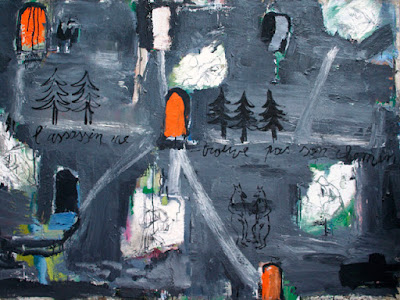Philippe Vandenberg (Ghent, 1952 - Brussels, June 29, 2009) was a Belgian painter.
Philippe Vandenberg was born in 1952 in Ghent, where the contact with the works of Hieronymus Bosch and Gustave Van de Woestijne at the Museum of Fine Arts will arouse fascination for painting. In 1970 he began his studies of Arts and Philosophy and Art History at the University of Ghent he stops in 1972 to fully focus on his studies of painting. In 1976 he graduated in the direction of painting at the Royal Academy of Fine Arts in Ghent and two years later he leaves for the first time to New York where he met the space in the work of Pollock, Rothko and Kline and was struck by 'The battle of the rebel Angels' Ensor.
Philippe Vandenberg was born in 1952 in Ghent, where the contact with the works of Hieronymus Bosch and Gustave Van de Woestijne at the Museum of Fine Arts will arouse fascination for painting. In 1970 he began his studies of Arts and Philosophy and Art History at the University of Ghent he stops in 1972 to fully focus on his studies of painting. In 1976 he graduated in the direction of painting at the Royal Academy of Fine Arts in Ghent and two years later he leaves for the first time to New York where he met the space in the work of Pollock, Rothko and Kline and was struck by 'The battle of the rebel Angels' Ensor.
A first visit to the Museo del Prado in 1980 developed his passion for Diego Velázquez, El Greco and Francisco Goya. Philippe Vandenberg remains fascinated by literature and met with Hugo Claus in 1985 resulting in the literary edition Proverbs, where the link is reinstated with the literature. Vandenberg then start his first sign books in which the drawing function allows the book. In 1994, he lives through Job and the Apocalypse, Augustine, Sophocles, Heiner Müller, San Juan de la Cruz and Emil Cioran. A year later he wrote the suite texts The state of things and the lamentations of the ship, which is published in dialogue with lithographs and book and he paints The Seventh Seal, composed a work of tiny, skimpy painted panels where besides oil also watercolor, gouache and blood may be used. Just as in the drawings begin to form the work ensembles.
Between 1996 and 1999 he repeatedly Marseille, birthplace of Antonin Artaud and Rimbaud retreat and start his visit with pencil and watercolor Les Carnets, a kind of diary which consist of drawings, watercolors and notes. He is interested in Georg Trakl and Paul Celan and paints the portrait of Artaud and Ulrike Meinhof. In 1999, his retrospective exhibition at the Museum of Contemporary Art Antwerp follows and writes the text On the way is a cage is a man, his hands red, an intermediate reflection on his work. Les Carnets come increasingly to the fore and it is assessed a major selection of drawings for the first time shown in 2003 under the title Daily Drawings of Good & Vile 1997-2003. The presentation of Pilgrims Keel, a publication with text and drawings of Philippe Vandenberg to a graphic design Inge Ketelers, the same year takes place at the Museum Dr. Guislain. In 2004, the Exile Peintre is issued, a bibliophile edition with etchings and text Lettre au Nègre Philippe Vandenberg (Ergo Press, 2004). The work of Philippe Vandenberg get text and image more intense dialogue with each other and this edition is a symbiosis of this. In 2008 Vandenberg 'Artist in Residence' at the Ghent Museum of Fine Arts, where he was confronted with the famous old masters.Wikipedia





No comments:
Post a Comment